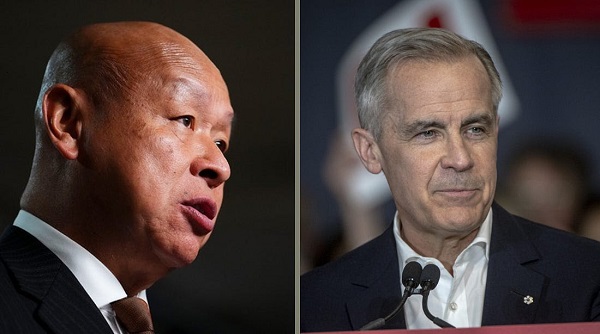Uncategorized
Hope fades in Philippines for dozens buried in landslides

ITOGON, Philippines — Dozens of people believed buried in a landslide unleashed by Typhoon Mangkhut in the Philippines probably did not survive, a mayor said Monday, although rescuers kept digging through mud and debris covering a chapel where they had taken shelter.
Of the 40 to 50 miners and their families believed inside the chapel, there is a “99
Mangkhut already is confirmed to have killed 65 people in the Philippines and four in China, where it weakened to a tropical storm as it churned inland Monday.
Palangdan said rescuers have recovered 11 bodies from the muddy avalanche, which covered a former bunkhouse for the miners that had been turned into a chapel. Dozens of people sought shelter there during the storm despite warnings it was dangerous.
“They laughed at our policemen,” he said. “They were resisting when our police tried to pull them away. What can we do?”
Police and soldiers were among the hundreds of rescuers with shovels and picks searching for the missing along a mountainside as grief-stricken relatives waited nearby, many of them praying quietly. Bodies in black bags were laid side by side. Those identified were carried away by relatives, some using crude bamboo slings.
Jonalyn Felipe said she had called her husband, Dennis, a small-scale gold miner in Itogon, and told him to return to their home in northern Quirino province as the powerful typhoon approached Friday.
“I was insisting because the storm was strong but he told me not to worry because they’re safe there,” said a weeping Felipe, adding that her husband was last seen chatting with fellow miners in the chapel before it was hit by the collapsing mountainside.
She said she screamed after hearing the news about her husband, and their 4-year-old son sensed what had happened and cried too.
Palangdan said authorities “will not stop until we recover all the bodies.”
Environmental Secretary Roy Cimatu said the government will deploy soldiers and police to stop illegal mining in six mountainous northern provinces, including Benguet, to prevent such tragedies.
Philippine officials say that gold mines tunneled by big mining companies and by unauthorized small miners have made the hillsides unstable and more prone to landslides. Tens of thousands of small-time miners have come in recent years to the mountain provinces from the lowlands and established communities in high-risk areas such as the mountain foothills of Itogon.
On Monday, Mangkhut was still affecting southern China’s coast and the provinces of Guangdong, Guangxi and Hainan, and rain and strong winds were expected to continue through Tuesday.
The storm was about 200
Life was gradually returning to normal along the hard-hit southern China coast, where high-rise buildings swayed, coastal hotels flooded and windows were blown out. Rail, airline and ferry services were restored and casinos in the gambling enclave of Macau reopened.
In Hong Kong, crews cleared fallen trees and other wreckage left from when the financial hub felt the full brunt of the storm Sunday.
“This typhoon really was super strong … but overall, I feel we can say we got through it safely,” Carrie Lam, the territory’s chief executive, told reporters.
The Hong Kong Observatory said Mangkhut was the most powerful storm to hit the city since 1979, packing winds of 195 kph (121 mph).
The typhoon struck Asian population
___
Associated Press writers Jim Gomez and Cecilia Forbes in Manila contributed to this report.
Joeal Calupitan And Aaron Favila, The Associated Press
Uncategorized
Kananaskis G7 meeting the right setting for U.S. and Canada to reassert energy ties


Energy security, resilience and affordability have long been protected by a continentally integrated energy sector.
The G7 summit in Kananaskis, Alberta, offers a key platform to reassert how North American energy cooperation has made the U.S. and Canada stronger, according to a joint statement from The Heritage Foundation, the foremost American conservative think tank, and MEI, a pan-Canadian research and educational policy organization.
“Energy cooperation between Canada, Mexico and the United States is vital for the Western World’s energy security,” says Diana Furchtgott-Roth, director of the Center for Energy, Climate and Environment and the Herbert and Joyce Morgan Fellow at the Heritage Foundation, and one of America’s most prominent energy experts. “Both President Trump and Prime Minister Carney share energy as a key priority for their respective administrations.
She added, “The G7 should embrace energy abundance by cooperating and committing to a rapid expansion of energy infrastructure. Members should commit to streamlined permitting, including a one-stop shop permitting and environmental review process, to unleash the capital investment necessary to make energy abundance a reality.”
North America’s energy industry is continentally integrated, benefitting from a blend of U.S. light crude oil and Mexican and Canadian heavy crude oil that keeps the continent’s refineries running smoothly.
Each day, Canada exports 2.8 million barrels of oil to the United States.
These get refined into gasoline, diesel and other higher value-added products that furnish the U.S. market with reliable and affordable energy, as well as exported to other countries, including some 780,000 barrels per day of finished products that get exported to Canada and 1.08 million barrels per day to Mexico.
A similar situation occurs with natural gas, where Canada ships 8.7 billion cubic feet of natural gas per day to the United States through a continental network of pipelines.
This gets consumed by U.S. households, as well as transformed into liquefied natural gas products, of which the United States exports 11.5 billion cubic feet per day, mostly from ports in Louisiana, Texas and Maryland.
“The abundance and complementarity of Canada and the United States’ energy resources have made both nations more prosperous and more secure in their supply,” says Daniel Dufort, president and CEO of the MEI. “Both countries stand to reduce dependence on Chinese and Russian energy by expanding their pipeline networks – the United States to the East and Canada to the West – to supply their European and Asian allies in an increasingly turbulent world.”
Under this scenario, Europe would buy more high-value light oil from the U.S., whose domestic needs would be back-stopped by lower-priced heavy oil imports from Canada, whereas Asia would consume more LNG from Canada, diminishing China and Russia’s economic and strategic leverage over it.
* * *
The MEI is an independent public policy think tank with offices in Montreal, Ottawa, and Calgary. Through its publications, media appearances, and advisory services to policymakers, the MEI stimulates public policy debate and reforms based on sound economics and entrepreneurship.
As the nation’s largest, most broadly supported conservative research and educational institution, The Heritage Foundation has been leading the American conservative movement since our founding in 1973. The Heritage Foundation reaches more than 10 million members, advocates, and concerned Americans every day with information on critical issues facing America.
Uncategorized
Poilievre on 2025 Election Interference – Carney sill hasn’t fired Liberal MP in Chinese election interference scandal

From Conservative Party Communications
“Yes. He must be disqualified. I find it incredible that Mark Carney would allow someone to run for his party that called for a Canadian citizen to be handed over to a foreign government on a bounty, a foreign government that would almost certainly execute that Canadian citizen.
“Think about that for a second. We have a Liberal MP saying that a Canadian citizen should be handed over to a foreign dictatorship to get a bounty so that that citizen could be murdered. And Mark Carney says he should stay on as a candidate. What does that say about whether Mark Carney would protect Canadians?
“Mark Carney is deeply conflicted. Just in November, he went to Beijing and secured a quarter-billion-dollar loan for his company from a state-owned Chinese bank. He’s deeply compromised, and he will never stand up for Canada against any foreign regime. It is another reason why Mr. Carney must show us all his assets, all the money he owes, all the money that his companies owe to foreign hostile regimes. And this story might not be entirely the story of the bounty, and a Liberal MP calling for a Canadian to be handed over for execution to a foreign government might not be something that the everyday Canadian can relate to because it’s so outrageous. But I ask you this, if Mark Carney would allow his Liberal MP to make a comment like this, when would he ever protect Canada or Canadians against foreign hostility?
“He has never put Canada first, and that’s why we cannot have a fourth Liberal term. After the Lost Liberal Decade, our country is a playground for foreign interference. Our economy is weaker than ever before. Our people more divided. We need a change to put Canada first with a new government that will stand up for the security and economy of our citizens and take back control of our destiny. Let’s bring it home.”
-

 Crime1 day ago
Crime1 day agoManhunt on for suspect in shooting deaths of Minnesota House speaker, husband
-

 Business23 hours ago
Business23 hours agoCarney’s European pivot could quietly reshape Canada’s sovereignty
-

 Aristotle Foundation5 hours ago
Aristotle Foundation5 hours agoThe Canadian Medical Association’s inexplicable stance on pediatric gender medicine
-

 Alberta22 hours ago
Alberta22 hours agoAlberta’s grand bargain with Canada includes a new pipeline to Prince Rupert
-

 conflict8 hours ago
conflict8 hours ago“Evacuate”: Netanyahu Warns Tehran as Israel Expands Strikes on Iran’s Military Command
-

 Bruce Dowbiggin7 hours ago
Bruce Dowbiggin7 hours agoWOKE NBA Stars Seems Natural For CDN Advertisers. Why Won’t They Bite?
-

 Energy7 hours ago
Energy7 hours agoCould the G7 Summit in Alberta be a historic moment for Canadian energy?
-

 Crime7 hours ago
Crime7 hours agoMinnesota shooter arrested after 48-hour manhunt






